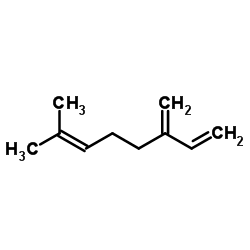Myrcene

Myrcene structure
|
Common Name | Myrcene | ||
|---|---|---|---|---|
| CAS Number | 123-35-3 | Molecular Weight | 136.234 | |
| Density | 0.8±0.1 g/cm3 | Boiling Point | 167.0±0.0 °C at 760 mmHg | |
| Molecular Formula | C10H16 | Melting Point | N/A | |
| MSDS | Chinese USA | Flash Point | 39.4±0.0 °C | |
| Symbol |



GHS02, GHS07, GHS08 |
Signal Word | Danger | |
|
Identification of odorants in frankincense (Boswellia sacra Flueck.) by aroma extract dilution analysis and two-dimensional gas chromatography-mass spectrometry/olfactometry.
Phytochemistry 109 , 66-75, (2014) Frankincense has been known, traded and used throughout the ages for its exceptional aroma properties, and is still commonly used in both secular and religious settings to convey a pleasant odor. Surprisingly, the odoriferous principle(s) underlying its uniqu... |
|
|
Identification of olfactory receptor neurons in Uraba lugens (Lepidoptera: Nolidae) and its implications for host range.
J. Insect Physiol. 78 , 33-46, (2015) Phytophagous insects detect volatile compounds produced by host and non-host plants, using species-specific sets of olfactory receptor neurons (ORNs). To investigate the relationship between the range of host plants and the profile of ORNs, single sensillum r... |
|
|
Surfactants, aromatic and isoprenoid compounds, and fatty acid biosynthesis inhibitors suppress Staphylococcus aureus production of toxic shock syndrome toxin 1.
Antimicrob. Agents Chemother. 53 , 1898-906, (2009) Menstrual toxic shock syndrome is a rare but potentially life-threatening illness manifest through the actions of Staphylococcus aureus toxic shock syndrome toxin 1 (TSST-1). Previous studies have shown that tampon additives can influence staphylococcal TSST-... |
|
|
Phytochemical analysis and in vitro biological activity of three Hypericum species from the Canary Islands (Hypericum reflexum, Hypericum canariense and Hypericum grandifolium).
Fitoterapia 100 , 95-109, (2015) In the present work we carried out a phytochemical and biological investigation on three Hypericum species, i.e. Hypericum reflexum, Hypericum canariense and Hypericum grandifolium, from the Canary Islands where they are traditionally used as diuretic, wound ... |
|
|
Eating Quality of Carrots (Daucus carota L.) Grown in One Conventional and Three Organic Cropping Systems over Three Years.
J. Agric. Food Chem. 63 , 9803-11, (2015) The eating quality of carrots (Daucus carota L.) was investigated to evaluate the impact of cropping systems (one conventional and three organic systems) and growing years (2007, 2008, and 2009) on root size, chemical composition, and sensory quality. The con... |
|
|
Relation between chemical composition or antioxidant activity and antihypertensive activity for six essential oils.
J. Food Sci. 77(8) , H184-91, (2012) Six essential oils (EOs), Juniperus phoenicea (leaves and berries), Thymus capitatus, Lauris nobilis, Melaleuca armillaris, and Eucalyptus gracilis, were screened for their antioxidant and antihypertensive activity as well as their chemical compositions. We i... |
|
|
Fumigant toxicity and acetylcholinesterase inhibitory activity of 4 Asteraceae plant essential oils and their constituents against Japanese termite (Reticulitermes speratus Kolbe).
Pestic. Biochem. Physiol. 113 , 55-61, (2014) This study investigated the fumigant toxicity of 4 Asteraceae plant essential oils and their constituents against the Japanese termite Reticulitermes speratus Kolbe. Fumigant toxicity varied with plant essential oils or constituents, exposure time, and concen... |
|
|
In vitro antitrypanosomal and antiplasmodial activities of crude extracts and essential oils of Ocimum gratissimum Linn from Benin and influence of vegetative stage.
J. Ethnopharmacol. 155(3) , 1417-23, (2014) Different parts of Ocimum gratissimum Linn are largely used in folk medicine for the treatment of many diseases, some of which related to parasitical infections as fevers and headaches. In order to validate their use and to clarify the plant part which posses... |
|
|
Wild celery (Smyrnium olusatrum L.) oil and isofuranodiene induce apoptosis in human colon carcinoma cells.
Fitoterapia 97 , 133-41, (2014) Smyrnium olusatrum (Apiaceae), well known as wild celery, is a biennal celery-scented plant used for many centuries as a vegetable, then abandoned after the introduction of celery. In the present work, the essential oil obtained from inflorescences and the am... |
|
|
Composition and antiproliferative effect of essential oil of Origanum vulgare against tumor cell lines.
J. Med. Food 17(10) , 1129-33, (2014) Cancer is a leading cause of death and is responsible for one in eight deaths worldwide. The use of herbs as complementary medicine for cancer, especially advanced cancer, has recently increased. The aim of this study was to evaluate in vitro, the antiprolife... |